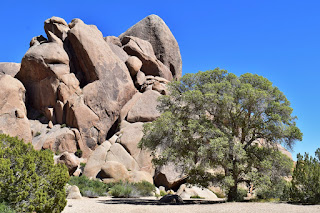Contact Information:
74485 National Park Drive
Twentynine Palms, CA 92277-3597
Phone: (760) 367-5500
Map:
Trails:
Barker Dam Nature Trail:
Barker Dam Nature Trail is a 1-mile loop that passes a reservoir created by its namesake. The trailhead is at the Barker Dam parking area just past Hidden Valley. The loop passes by a desert oasis that was built for watering livestock but is now a water source for wildlife. It then passes through a desert valley and a small cave where petroglyphs can be seen.
Cholla Cactus Garden Trail:
Cholla Cactus Garden Trail is a quarter-mile loop around the cholla garden. The trailhead is along Pinto Basin Road about 20 miles north of Cottonwood Visitor Center. The trail leads through a natural garden of teddy bear chollas.
Wall Street Mill Trail:
Wall Street Mill is a 1-mile trail that leads to its namesake. The trailhead is at Barker Dam Trailhead or the gravel Wall Street Mill Road. It's a flat trail through the desert. About half way is the Desert Queen Well. Further on is the Worth Bagley Stone. The trail ends at Wall Street Mill where the remains of the old stamp mill are visible. There are also a couple old vehicles that were abandoned by the mill.
Points of Interest:
Barker Dam:
Barker Dam and reservoir is located along the Barker Dam Nature Trail. The dam was constructed to make a lake to provide drinking water to livestock. Now, it's a water source for wildlife.
Desert Queen Well:
The Desert Queen Well is located along Wall Street Mill Trail, about a half-mile from the trailhead at Barker Dam.
Live Oak:
The live oak is a large hybrid white oak tree that has managed to survive and flourish in the harsh desert environment. The Live Oak Picnic Area is right across from Split Rock; turn right before the picnic area and drive to the end to see the oak.
Petroglyphs:
Petroglyphs can be found in a small cave along the Barker Dam Nature Trail.
Skull Rock:
Skull Rock is an eroded rock that resembles a human skull. It's close to the road near Jumbo Rocks Campground and the Skull Rock Nature Trail passes by it.
Wall Street Mill:
Wall Street Mill is located at the end of Wall Street Mill Trail. The stamp will was used to process gold ore and the conveyor is still visible.
Several old cars can be seen at the mill site.
Worth Bagley Stone:
The Worth Bagley Stone is located along Wall Street Mill Trail between Desert Queen Well and the mill. The stone was carved by William F. Keys after he killed Worth Bagley in a gunfight over water rights on May 11, 1943. Mr. Keys was convicted of manslaughter and served time in San Quentin Prison before returning to Keys Ranch.
Wildlife:
The transition between the Mojave and Colorado deserts supports a wide variety of desert life. The park is named for the Joshua Tree (Yucca brevifolia), a species of Yucca that lives primarily in the northern part of the park in the Mojave desert. The Joshua Tree makes beautiful flowers in the spring.
Another species of yucca found in Joshua Tree is the banana yucca (Yucca baccata), which produces fruit that look like small bananas.
Strawberry hedgehog cactus (Echinocereus engelmannii) has purple flowers.
Scarlet hedgehog cactus (Echinocereus coccineus) has red flowers.
Teddy bear cholla (Cylindropuntia bigelovii) appear "cute and fuzzy" from a distance, but have wicked thorns so be careful not to brush against them. They are found throughout the park, but the densest concentration is in the Cholla Garden.
Ocotillo (Fouquieria splendens) is a desert shrub and not a cactus, but it's stems are covered in thorns. The plant produces conspicuous red flowers at the end of the stems.
Desert live-forever (Dudleya saxosa)
California Evening Primrose (Oenothera californica)
Whitedaisy tidytips (Layia glandulosa)
Desert dandelion (Malacothrix glabrata)
Woolly Daisy (Eriophyllum wallacei)
Common fiddleneck (Amsinckia menziesii)
Desert Bluebells (Phacelia campanularia)
Fremont's phacelia (Phacelia fremontii)
Desert Indian Paintbrush (Castilleja angustifolia)
Desert cottontail (Sylvilagus audubonii) is a species of rabbit commonly found in the park.
Great basin fence lizard (Sceloporus occidentalis longipes) is a lizard commonly found in the park. They are often seen doing "push-ups".
Blog Entries:
17-Apr-2019: Rock Climbing in Joshua Tree
16-Apr-2019: Joshua Tree Adventures
External Links:
National Park Service website: https://www.nps.gov/jotr/index.htm





























No comments:
Post a Comment